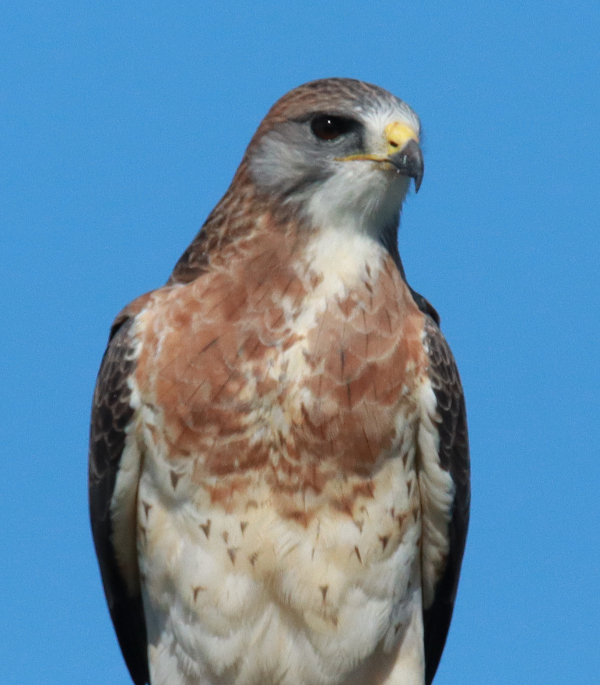
Representing the last opportunity to photograph a Swainson’s Hawk before the species as a whole migrated south, this impressive raptor shows a unique extension of a line of white feathers that continues down its breast from its white throat plumage. Usually the breast feathers are a rather uniform chestnut-brown.
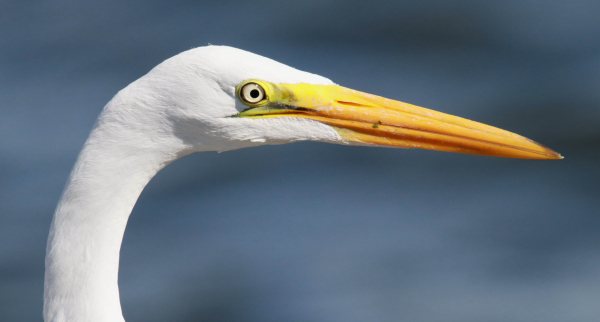
A hunting Great Egret’s body was hidden behind vegetation, but it provided a close portrait photo when it lifted its head above the plants.
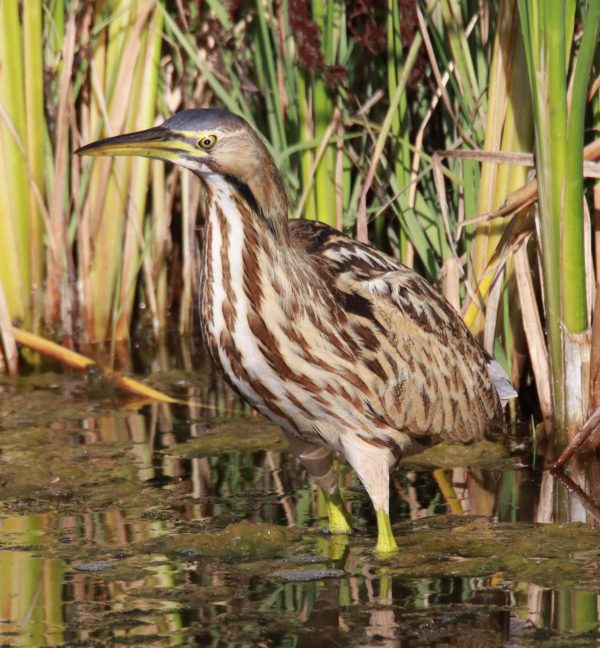
A pair of photos show an American Bittern hunting on the edge of cattails, then extending its neck upward, probably in reaction to eventually seeing the photographer and thereby providing 2 different views of the wading bird.
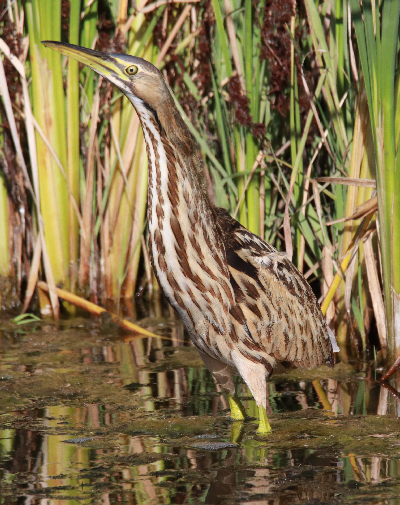
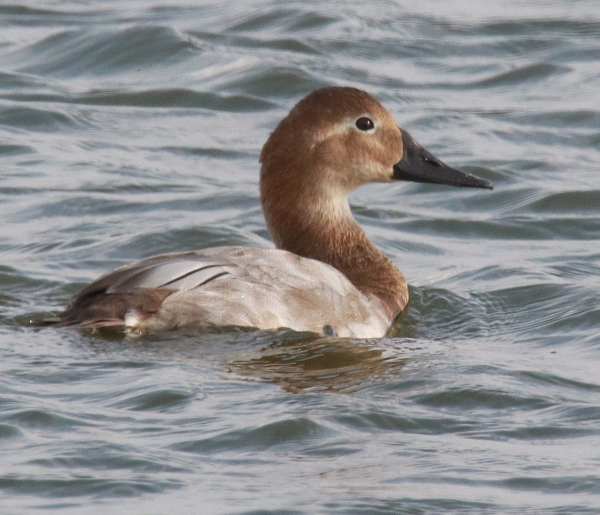
The telltale slope of the female Canvasback’s head toward its large bill is an obvious indicator of the species in the field.
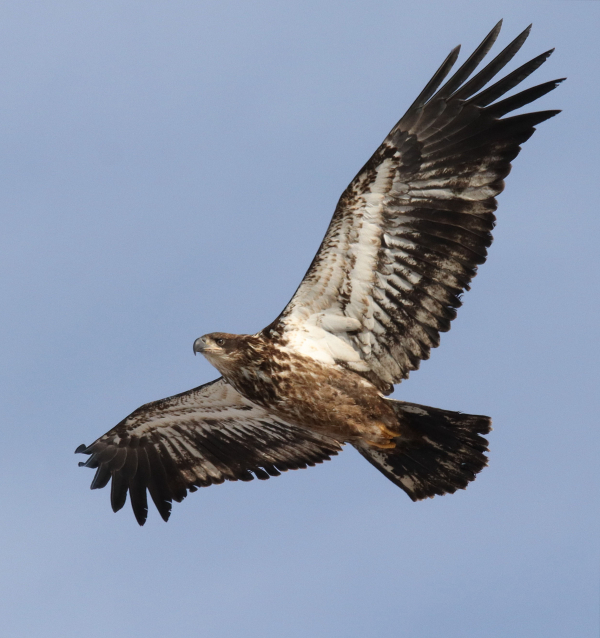
This young Bald Eagle was 1 of 7 encountered during Friday’s birding drive, when they all seemed to be migrating south. The eagles were observed in groups of 2, 2, 2, and 1.
|
There was a more noticeable fall migration this week, to the point that migrating birds actually spilled into my yard – exciting birds like the first of fall Harris’s Sparrow, the first White-throated Sparrow, and the first Dark-eyed Juncos, all feeding together Monday morning. A Ruby-crowned Kinglet, Yellow-rumped Warbler, and a returning White-breasted Nuthatch were evident during the afternoon, and the previous day, Sunday, the first 2 fall flocks of Yellow-rumped Warblers filtered through my trees a few hours apart. The earlier flock was led by a White-breasted Nuthatch, while the latter warbler flock also contained a gem – a Brown Creeper. Also, about a dozen Chipping Sparrows made a stop Friday morn – so my yard action really ramped up after quite a lull.
Overnight Saturday and Sunday (October 4 and 5) were forecast to be high migration nights by BirdCast, and the birds in my yard were a very small part of the migration that passed overhead those nights. When I referred to BirdCast over the weekend, I found it interesting to see the peak nights of migration so far this fall: In my county of North Dakota the peak night migrations started with a big one August 21st, followed by September migrations on the nights of the 20th, 22nd, 26th, plus the first weekend of October, the 4th and 5th. The biggest migration night to date was the September 20th followed by the 23rd, with Sunday’s migration almost as big. BirdCast estimated Sunday’s peak migration was at 11pm, when an estimated 1,106,100 birds were flying at an average speed of 35mph at an average altitude of 2,500 feet over the county!
Considering the new birds appearing in my yard Sunday and Monday, and the depth of the overnight migration, I was excited to see what I would find in the surrounding area later in the afternoon. I checked on the usual sites to the southeast, but found surprisingly little avian activity – until I made it to White Lake, which has some surrounding trees and features one of the best locations to find some native sparrows and juncos. Considering the paucity of birds up to that point I didn’t expect that locale to hold songbirds, but indeed there were many American Robins, and a few juncos, 2 Harris’s Sparrows, 3 White-throated Sparrows, and the first of fall White-crowned Sparrow. It turned out there were as many as 50 robins in the immediate area, along with a single Belted Kingfisher, and 2 Red-tailed Hawks flew along the hillside to the east a half-hour apart as though migrating south.
After spending time at the sparrow spot to photograph with some success, as the light began to wane, the songbirds flushed collectively, prompting me to prepare to leave. But as I looked for a potential raptor, a suspicious-looking hawk landed in a tall tree for a moment, then flew east. Woo-wee, it turned out to be a dark morph Rough-legged Hawk, the first of fall, appearing just 4 days after seeing the last Swainson’s Hawk. One Buteo species leaves as another arrives; one headed south to Argentina, one arriving from the Arctic!
The Bigger Picture
Thursday and Friday I covered an expansive area to monitor migration highlights between the western edge of the Drift Plain to the Missouri River (about 125 miles) and from the border between the Dakotas to Bismarck (about 60 miles) and south of Interstate 94. By driving different routes about 20 miles apart I covered the area pretty well to appreciate the pulse of the ongoing fall migration. Bald Eagles and Turkey Vultures were on active migration flights, while American Kestrels were both on the move and perched, and a lone Merlin was sighted winging south. Almost all Swainson’s Hawks had vacated the region, as expected, but I did find 3 Swainson’s within the same half-mile, with one lending a photo op – likely the last photo of this iconic Dakota species this season.
Other birds apparently on the move were a late flock of White Pelicans, flocks of Killdeer, Franklin’s Gulls, Ring-billed Gulls, American Robins, Red-tailed Hawks, a scattering of Great Egrets, a few Great Blue Herons, and a Bittern. Ducks were abundant with flocks of American Wigeons standing out, along with new flocks of Northern Pintails, Gadwalls, Redheads, Northern Shovelers, Mallards, Green-winged Teal, a few Canvasbacks, and some new flocks of Ruddy Ducks and American Coots. I also checked back on the Sandhill Cranes that are assembling on the north edge of Long Lake National Wildlife Refuge, which seemed to increase to about 250 by Friday.
Overall, raptors on hand but their numbers were obviously reduced with far fewer Red-tails, and Swainson’s Hawks all but gone. A count along the Raptor Route yielded only 12 Red-tailed Hawks, 1 Northern Harrier, and 1 American Kestrel. Similarly, the Southeast Route only provided a look at 2 American Kestrels, 8 Red-tails, and 2 Northern Harriers. Far to northwest, on the northwest edge of Long Lake Refuge I found a pair of adult Bald Eagles soaring together, and a 4th-year Bald Eagle a couple miles away, all possibly migrating.
About 10 miles farther northwest I witnessed a similar scenario at McKenzie Slough, where a pair of adult Bald Eagles flew in from the north, soared ever higher on a thermal and exited to the south. After checking out a migrating Turkey Vulture, a first-fall Bald Eagle flew into view from the north, passing directly over my position and circling upward thereafter before heading south again. While that was happening, I noticed a second first-fall Bald Eagle perched in a low tree in the middle of the McKenzie hotspot – big excitement among the big birds!
Maybe the biggest surprise last week was that when I checked back on the “skeleton tree” Wednesday, Saturday, and Monday and found it unusually vacant, but maybe the big, barkless gray-white silhouette of a tree is more of a September attractant. Nonetheless, I’ll be checking back regularly, ’cuz it only takes a single bird to give me a jolt of adrenaline and a chance for a memorable photo. With migration gearing up, make the most of the next week – especially with the October Big Day event coming up this Saturday – Enjoy!
Article and Photos by Paul Konrad
Share your bird sightings and photographs at editorstbw2@gmail.com